
Genus: Kulindadromeus GODEFROIT, SINISTA, DHOUALLY, BOLOTSKY, SIZOV,
McNAMARA, BENTON & SPAGNA, 2014
Etymology: Kulinda, Olov Depression, Cherynyshevsky District, Chita Region,
southeastern Siberia, Asian Russia, in reference to the type locality, and Greek, dromeus,
"runner."
= Kulindapteryx ALIFANOV & SAVELIEV,
2014
Etymology: From the Kulinda locality, Olov Depression, Cherynyshevsky District, Chita Region,
southeastern Siberia, Asian Russia and Greek, pteryx, "wing."
= Lepidocheirosaurus ALIVANOV, & SAVELIEV, 2015
Etymology: Greek, lepis, "scale," Greek, cheiros, "hand," and Greek, sauros,
"lizard."
Species: zabaikalicus GODEFROIT, SINISTA, DHOUALLY, BOLOTSKY,
SIZOV, McNAMARA, BENTON & SPAGNA,
2014
Etymology: From Zabaikal krai region, southeastern Siberia, Asian Russia, where the new dinosaur was discovered.
Holotype: INREC K3/109
Locality: Kulinda, Olov Depression, Cherynyshevsky District, Chita Region, southeastern Siberia, Asian Russia.
Horizon: Base of the Ukureyskaya Formation.
Biosratigraphy:
Age: Aalenian Stage, Early Dogger Epoch, early Middle Jurassic.
Material: Skull.

Skull.
Referred material:
INREC K3/112: Dorsal vertebra.
INREC K3/113: Left ilium.
INREC K3/114: Left pubis.
INREC K3/124: Right ischium.
INREC K3/134: Right scapula.
INREC K3/200: Dentary teeth.
INREC K3/202: Distal caudal vertebra.
INREC K3/203: Associated left humerus and scapula.
INREC K3/204: Proximal portion of right scapula.
INREC K3/205: Left ulna.
INREC K3/206: Right femur.
INREC K3/207: Right tibia.
INREC K4/22: Partial skull.
INREC K4/42: Right maxilla.
INREC K4/57: Scales around the tibia and around the tarsus.
INREC K4/72: Right metatarsus.
INREC K4/94: Double row of scales above the proximal part of the tail.
INREC K4/116: Distal portio of left (?) femur with 'feather impressons'.
INREC K4/117: Caudal scales.
INREC K4/118: Scales around the right metatarsus and pes.
INREC K4/150: Proximal caudal vertebrae.
INREC K4/159: Distal caudal vertebrae.
INREC K4/200: Dentary teeth.
INREC K4/201: Right dentary ramus.
= Kulindapteryx ukureica ALIFANOV & SAVELIEV, 2014
Etymology: From the Ukureisk Formation.Holotype: PIN no. 5434/25
Locality: Kulinda locality, Orlovskaya Depression, Olov Depression, Cherynyshevsky District, Chita Region, southeastern Siberia, Asian Russia. Transbaikala.
Horizon: Ukureisk Formation.
Biostratigraphy:
Age: Tithonian Stage, Upper Malm Epoch, Late Jurassic.
Material: Fragmentary vertebrae, ischium and pubis on matrix.
= Lepidocheirosaurus natatilis ALIVANOV, & SAVELIEV, 2015
Etymology: Latin, natatilis, "capable of swimming."Holotype: PIN, no. 5435/1
Locality: Kulinda locality, Orlovskaya Depression, Olov Depression, Cherynyshevsky District, Chita Region, southeastern Siberia, Asian Russia. Transbaikala.
Horizon: Ukureisk Formation.
Biostratigraphy:
Age: Tithonian Stage, Upper Malm Epoch, Late Jurassic.
Material: Incomplete left manus, with imprtins of scales and ungual sheath.
Referred material:
PIN , nos, 5434/2, 56, 63-65, 67: Isolated posterior caudal vertebrae.
PIN, nos,. 5435/12, 50-52, 54, 62-64: Series of audal vertebrae with impritns of integumenary over.